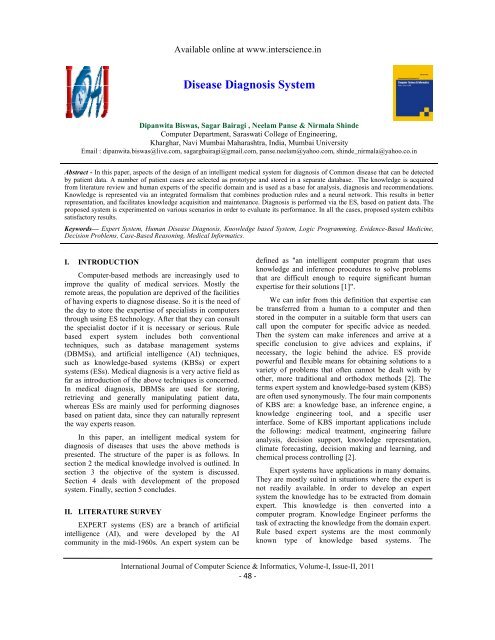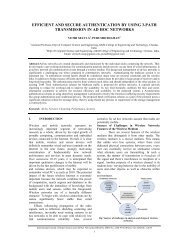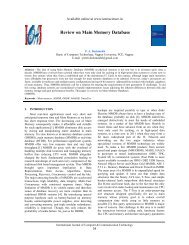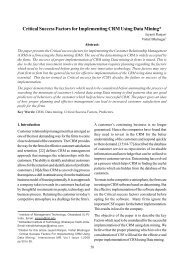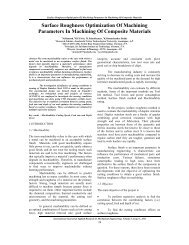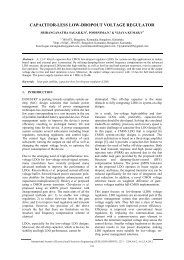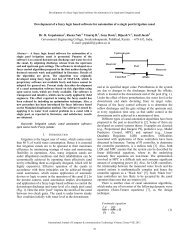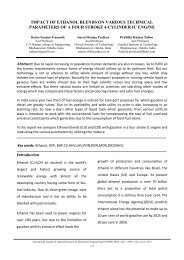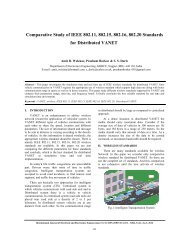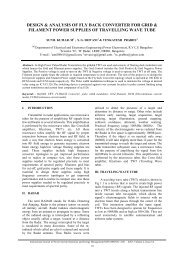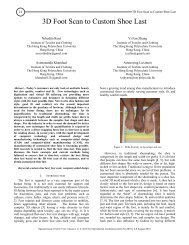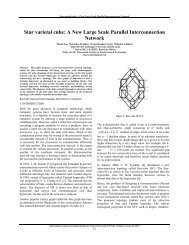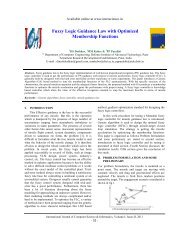Disease Diagnosis System
Disease Diagnosis System
Disease Diagnosis System
You also want an ePaper? Increase the reach of your titles
YUMPU automatically turns print PDFs into web optimized ePapers that Google loves.
Available online at www.interscience.in�<br />
<strong>Disease</strong> <strong>Diagnosis</strong> <strong>System</strong><br />
Dipanwita Biswas, Sagar Bairagi , Neelam Panse & Nirmala Shinde<br />
Computer Department, Saraswati College of Engineering,<br />
Kharghar, Navi Mumbai Maharashtra, India, Mumbai University�<br />
Email : dipanwita.biswas@live.com, sagargbairagi@gmail.com, panse.neelam@yahoo.com, shinde_nirmala@yahoo.co.in<br />
Abstract - In this paper, aspects of the design of an intelligent medical system for diagnosis of Common disease that can be detected<br />
by patient data. A number of patient cases are selected as prototype and stored in a separate database. The knowledge is acquired<br />
from literature review and human experts of the specific domain and is used as a base for analysis, diagnosis and recommendations.<br />
Knowledge is represented via an integrated formalism that combines production rules and a neural network. This results in better<br />
representation, and facilitates knowledge acquisition and maintenance. <strong>Diagnosis</strong> is performed via the ES, based on patient data. The<br />
proposed system is experimented on various scenarios in order to evaluate its performance. In all the cases, proposed system exhibits<br />
satisfactory results.<br />
Keywords—�Expert <strong>System</strong>, Human <strong>Disease</strong> <strong>Diagnosis</strong>, Knowledge based <strong>System</strong>, Logic Programming, Evidence-Based Medicine,<br />
Decision Problems, Case-Based Reasoning, Medical Informatics.�<br />
.<br />
I. INTRODUCTION<br />
Computer-based methods are increasingly used to<br />
improve the quality of medical services. Mostly the<br />
remote areas, the population are deprived of the facilities<br />
of having experts to diagnose disease. So it is the need of<br />
the day to store the expertise of specialists in computers<br />
through using ES technology. After that they can consult<br />
the specialist doctor if it is necessary or serious. Rule<br />
based expert system includes both conventional<br />
techniques, such as database management systems<br />
(DBMSs), and artificial intelligence (AI) techniques,<br />
such as knowledge-based systems (KBSs) or expert<br />
systems (ESs). Medical diagnosis is a very active field as<br />
far as introduction of the above techniques is concerned.<br />
In medical diagnosis, DBMSs are used for storing,<br />
retrieving and generally manipulating patient data,<br />
whereas ESs are mainly used for performing diagnoses<br />
based on patient data, since they can naturally represent<br />
the way experts reason.<br />
In this paper, an intelligent medical system for<br />
diagnosis of diseases that uses the above methods is<br />
presented. The structure of the paper is as follows. In<br />
section 2 the medical knowledge involved is outlined. In<br />
section 3 the objective of the system is discussed.<br />
Section 4 deals with development of the proposed<br />
system. Finally, section 5 concludes.<br />
II. LITERATURE SURVEY<br />
EXPERT systems (ES) are a branch of artificial<br />
intelligence (AI), and were developed by the AI<br />
community in the mid-1960s. An expert system can be<br />
defined as "an intelligent computer program that uses<br />
knowledge and inference procedures to solve problems<br />
that are difficult enough to require significant human<br />
expertise for their solutions [1]".<br />
We can infer from this definition that expertise can<br />
be transferred from a human to a computer and then<br />
stored in the computer in a suitable form that users can<br />
call upon the computer for specific advice as needed.<br />
Then the system can make inferences and arrive at a<br />
specific conclusion to give advices and explains, if<br />
necessary, the logic behind the advice. ES provide<br />
powerful and flexible means for obtaining solutions to a<br />
variety of problems that often cannot be dealt with by<br />
other, more traditional and orthodox methods [2]. The<br />
terms expert system and knowledge-based system (KBS)<br />
are often used synonymously. The four main components<br />
of KBS are: a knowledge base, an inference engine, a<br />
knowledge engineering tool, and a specific user<br />
interface. Some of KBS important applications include<br />
the following: medical treatment, engineering failure<br />
analysis, decision support, knowledge representation,<br />
climate forecasting, decision making and learning, and<br />
chemical process controlling [2].<br />
Expert systems have applications in many domains.<br />
They are mostly suited in situations where the expert is<br />
not readily available. In order to develop an expert<br />
system the knowledge has to be extracted from domain<br />
expert. This knowledge is then converted into a<br />
computer program. Knowledge Engineer performs the<br />
task of extracting the knowledge from the domain expert.<br />
Rule based expert systems are the most commonly<br />
known type of knowledge based systems. The<br />
�<br />
International Journal of Computer Science & Informatics, Volume-I, Issue-II, 2011<br />
�������<br />
�
knowledge is represented in the form of IF-THEN rules.<br />
Figure 2 shows different modules for a rule-based expert<br />
system.<br />
Figure 2: Expert <strong>System</strong> Architecture.<br />
Expert systems have been developed and applied to<br />
many fields.<br />
Knowledge is a theoretical or practical<br />
understanding of a subject or a domain. In other words,<br />
Knowledge is the sum of what is currently known.<br />
<strong>Diagnosis</strong> system is a system which can diagnose<br />
diseases through checking out the symptoms. A<br />
knowledge based online diagnosis system is developed<br />
for diagnosis of diseases based on the knowledge given<br />
by doctors in the system.<br />
All health care professionals including doctors<br />
medical students, pharmacists can keep their knowledge<br />
up-to-date regarding “Red-eye diagnoses and treatment”,<br />
as its knowledge base external database is updated on<br />
regular basis.<br />
III. OBJECTIVE<br />
The objectives of the proposed expert systems are:-<br />
To implement the IT in real world problems.<br />
To assist doctors for various diseases associated<br />
with symptoms i.e. to be a home assistant for<br />
doctors.<br />
To assist Medical students working as in<br />
pathological labs.<br />
To help general practice doctors, nurses,<br />
nursing students etc and to assist the eye<br />
patients as first aid diagnosis<br />
To provide researchers a huge and up-to-date<br />
repository of information regarding various<br />
diseases.<br />
IV. PROPOSED SYSTEM<br />
A Medical <strong>Diagnosis</strong> <strong>System</strong> is developed with the<br />
purpose of assisting the Physician in diagnosing several<br />
diseases. It retrieves data from previous records to<br />
<strong>Disease</strong> <strong>Diagnosis</strong> <strong>System</strong> �<br />
�<br />
improve the accuracy of current diagnosis, indicates and<br />
analyses laboratory exams and lists all the possible<br />
diseases that the patient may have.<br />
The main objective of this system is to produce<br />
relevant data and information for consultations, and with<br />
the results obtained at this stage, produce possible<br />
diagnoses. In the definition of this process, 3 modules<br />
were created, to be used by specialists. In the first<br />
module, it is possible for a specialist or any medical<br />
committee to define which symptoms, clinical exams or<br />
laboratory exams are relative to one or more illnesses<br />
and, thereby, attribute the values (statistical weights) or<br />
results that define the illness. This Means, for instance,<br />
that blood pressure can be associated to the <strong>Diagnosis</strong> of<br />
High Blood Pressure, Diabetes, Pregnancy Risk, or renal<br />
failure, among others. It also indicates, in some cases,<br />
weather this symptom result provides the certainty of<br />
diagnosis or not. Information from previous<br />
consultations and examinations are automatically linked<br />
and analysed under temporal logic reasoning.<br />
In the second module, the system allows<br />
consultations whereby the relevant data for the patient is<br />
recorded and related to other correlated exams. Data not<br />
considered are discarded. During the stage of diagnosis,<br />
the system may suggest other tests or procedures to then<br />
decide whether there are other risks or diseases to be<br />
further investigated.<br />
In the third module, a diagnosis is made whereby the<br />
system removes refutes diagnosis, redefines the<br />
remaining ones (if necessary). Also, this system searches<br />
out levels of illnesses according to exam results. It may<br />
also suggest further investigation whenever data is not<br />
enough to ensure a precise diagnose; If no further<br />
information exists, it can reason under incomplete<br />
information relaying on current data.<br />
Finally, the system asks what results will be<br />
considered for the formation of the diagnoses, and then<br />
asks the doctor which diagnoses are confirmed<br />
Fig:- Expert system Architecture<br />
�<br />
International Journal of Computer Science & Informatics, Volume-I, Issue-II, 2011<br />
��
V. METHODOLOGY<br />
Methodology for development of th the CADRE is<br />
given as under.<br />
• SCOPE & LIMITATIONS<br />
The diagnosis deals with followi wing common<br />
diseases:<br />
Malaria, Chicken pox, Diarrhoea, Diabe betics, Cholera,<br />
Jaundice, Hepatitis, Typhoid, , Thyroid,<br />
Alzeimer’s<strong>Disease</strong>, Bronchitis, Migraine, , Scatia S<br />
• KNOWLEDGE ACQUISITION<br />
Searching for relevant books, , libraries and<br />
World Wide Web (WWW).<br />
Meetings with ophthalmologis gists, medical<br />
students and patients.<br />
Personnel observations and getting ing historical<br />
data from various ophthalmology y cclinics,<br />
depts.<br />
and wards in hospital, free eye cam amps, other<br />
health care units and medical colle lleges.<br />
• KNOWLEDGE REPRESENTATION<br />
Using production rules facilitated d bby<br />
MATLAB<br />
Storing additional information using u external<br />
database.<br />
• SOFTWARE DEVELOPMENT<br />
Different software modules, like: MMATLAB,<br />
MS<br />
Excel, Visual Basic, were integrated to develop the<br />
software. Validity of software was checke cked for sample<br />
data being acquired through various sources ces.<br />
• IMPLEMENTATION & MAINTENAN ANCE<br />
Expanding scope of the system by gi giving it inputs<br />
from different sources like World Wide de Web, recent<br />
research conducted in the field of op ophthalmology.<br />
Implementation of software in different ent health care<br />
depts.: e.g. hospitals, clinics medical colle ollege labs, free<br />
camps etc.<br />
VI. SCREENSHOTS<br />
Fig:- Input Scree<br />
<strong>Disease</strong> <strong>Diagnosis</strong> <strong>System</strong> �<br />
�<br />
International Journal of f Computer C Science & Informatics, Volume-I, Issue-II, 201 011<br />
��<br />
�<br />
Fig:- User Interface<br />
Fig: Acccuracy Level of the he system<br />
VII. CONCLUSION<br />
In this paper, a case-based med edical expert system<br />
prototype that supports diagnosis of Common diseases<br />
was developed. Several properties of this model remain<br />
to be investigated. It should be teste sted on several more<br />
databases. Unfortunately databas ases are typically<br />
proprietary and difficult to obtain. FFuture<br />
prospects for<br />
medical databases should be good si since some hospitals<br />
are now using computerized record rd systems instead of<br />
traditional paper-based. It should d be fairly easy to<br />
generate data for machine diagnos osis. One important<br />
aspect of automated diagnosis is the accompanying<br />
explanation for the conclusion, a fact actor that is important<br />
for user acceptance. A trained expert ert would evaluate the<br />
quality of the diagnosis performe med by the system,<br />
followed by adjustment of the ut utilities. Knowledge<br />
structure was represented via a fo formalism of cases.<br />
Cardiologists evaluate the system perf erformance by testing<br />
it practically for 13 new cases s where the system<br />
succeeded in estimating the correct t diagnosis. d For future<br />
work, more cases will be added to the th case memory and<br />
it will be clinically tested.
VIII. REFERENCE<br />
[1] Russell, S. and P. Norvig, 2002. Artificial<br />
Intelligence: A Modern Approach, Prentice Hall,<br />
Second Edition.<br />
[2] Beverly G. Hope, Rosewary H. Wild, « AnExpert<br />
Support <strong>System</strong> for Service Quality<br />
[3]<br />
Improvement», Proceedings of the Twenty-<br />
Seventh Annual Hawaii International Conference<br />
on <strong>System</strong> Science, 1994.<br />
Azaab S., Abu Naser S., and Sulisel O.,2000. A<br />
proposed expert system for selecting exploratory<br />
factor analysis procedures, Journal of the college<br />
of education, 4(2):9-26.<br />
[4] Knowledge Representation For The Nursing<br />
<strong>Diagnosis</strong> By Means Of An Expert <strong>System</strong> by M.<br />
Lourdes Jiménez, José M. Santamaría,<br />
[5]<br />
L.González1. Á.L. Asenjo, L.M. Laita, M.<br />
Beamud<br />
Analysis and design of information systems by<br />
V.Rajaraman, 5 th print, PHI, pp 113-137<br />
[6] An expert diagnostic tool for engineering systems<br />
by A K Verma & K Seetharam ( journal of<br />
scientific & Industrial research, vol 53, pp 601-<br />
603)<br />
[7] Discrete mathematical structures with applications<br />
to computer science by J.P.Tremblay & R.<br />
manohar, TMH, pp 8-1<br />
[8] Joseph Giarratano, Gary Riley (2004). Expert<br />
<strong>System</strong>s: Principles and Programming, Fourth<br />
Edition.<br />
�<br />
<strong>Disease</strong> <strong>Diagnosis</strong> <strong>System</strong> �<br />
�<br />
[9] Shu-Hsien Liao (2005). Expert system<br />
methodologies and applications - a decade review<br />
from 1995 to 2004, Expert <strong>System</strong>s with<br />
Applications, 28, 93-103.<br />
[10] Jeff Pepper (1990). An Expert <strong>System</strong> for<br />
Automotive <strong>Diagnosis</strong> in Ray Kurzweil's book,<br />
The Age of Intelligent Machines.<br />
[11] Daoliang Lia, Zetian Fua, Yanqing Duanb (2002).<br />
Fish-Expert: a webbased expert system for fish<br />
disease diagnosis, Expert <strong>System</strong>s with<br />
Applications, 23, 311-320.<br />
[12] Yu Qian*, Xiuxi Li, Yanrong Jiang, Yanqin Wen<br />
(2003). An expert system for real-time failure<br />
diagnosis of complex chemical processes, Expert<br />
<strong>System</strong>s with Applications, 24, 425-432.<br />
[13] Deschamps, D., & Fernandes, A. M. (2000). A<br />
expert system to diagnosis periodontal disease.<br />
Proceedings of Sixth Internet World Congress for<br />
Biomedical Sciences in Ciudad Real, Spain.<br />
[14] Guvenir, H. A., & Emeksiz, N. (2000). An expert<br />
system for the differential diagnosis of<br />
erythemato-seuamous diseases. Expert <strong>System</strong>s<br />
with Applications, 18, 43–49.<br />
���<br />
�<br />
International Journal of Computer Science & Informatics, Volume-I, Issue-II, 2011<br />
���<br />
�


